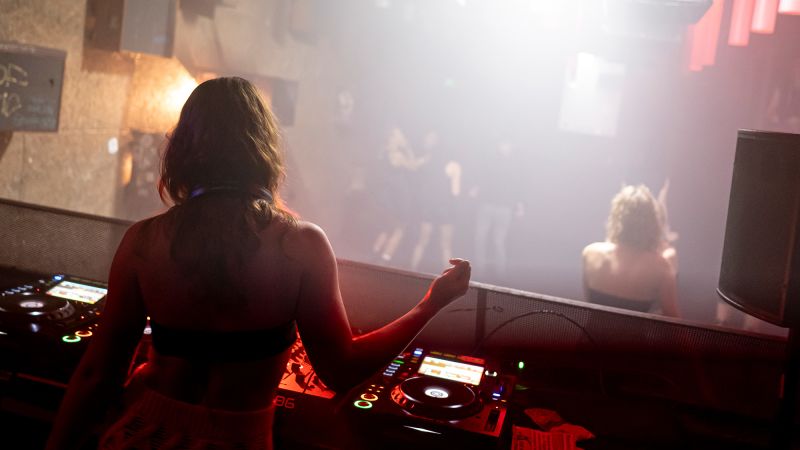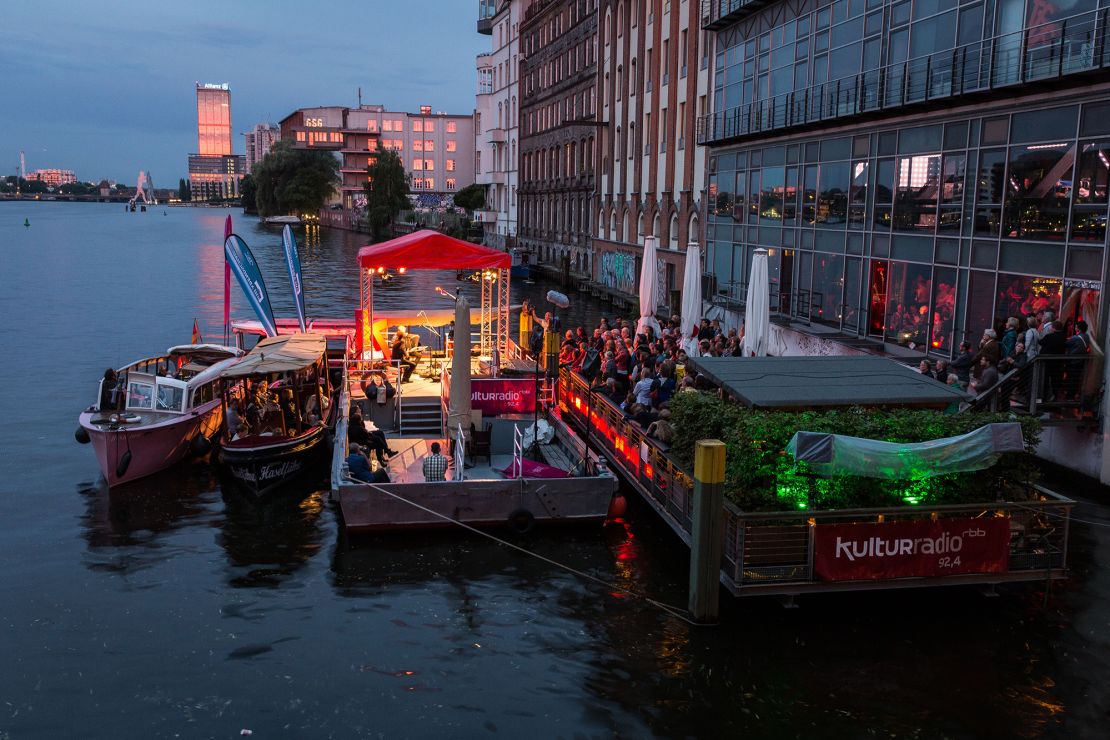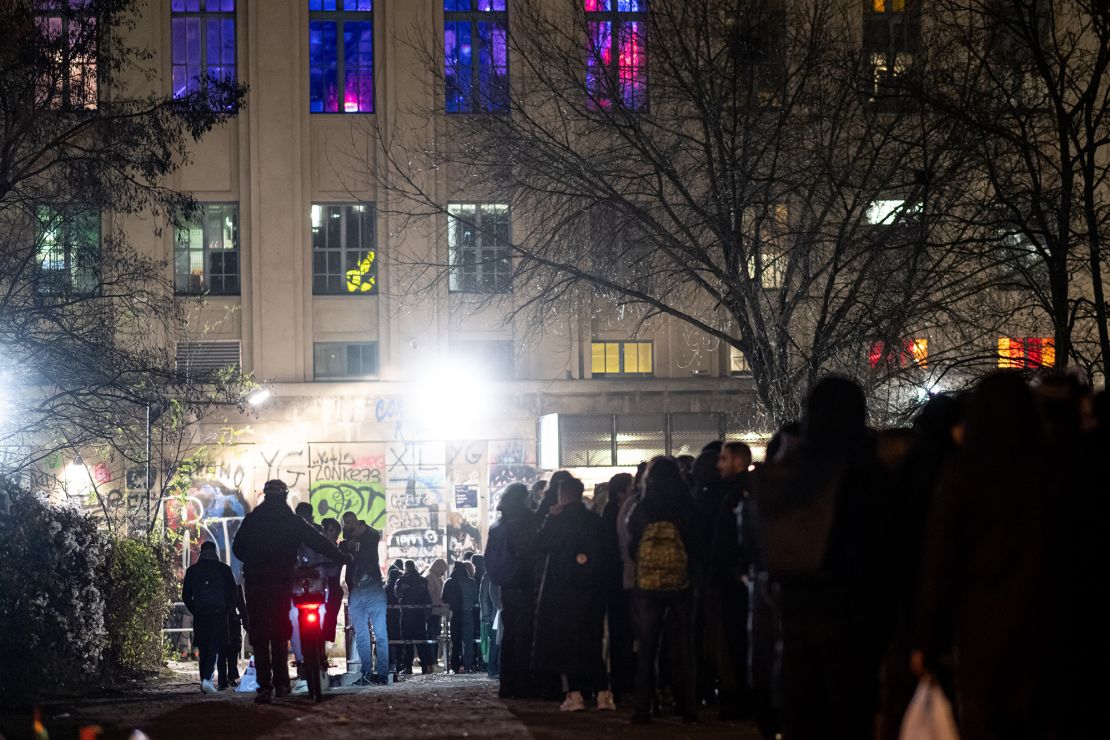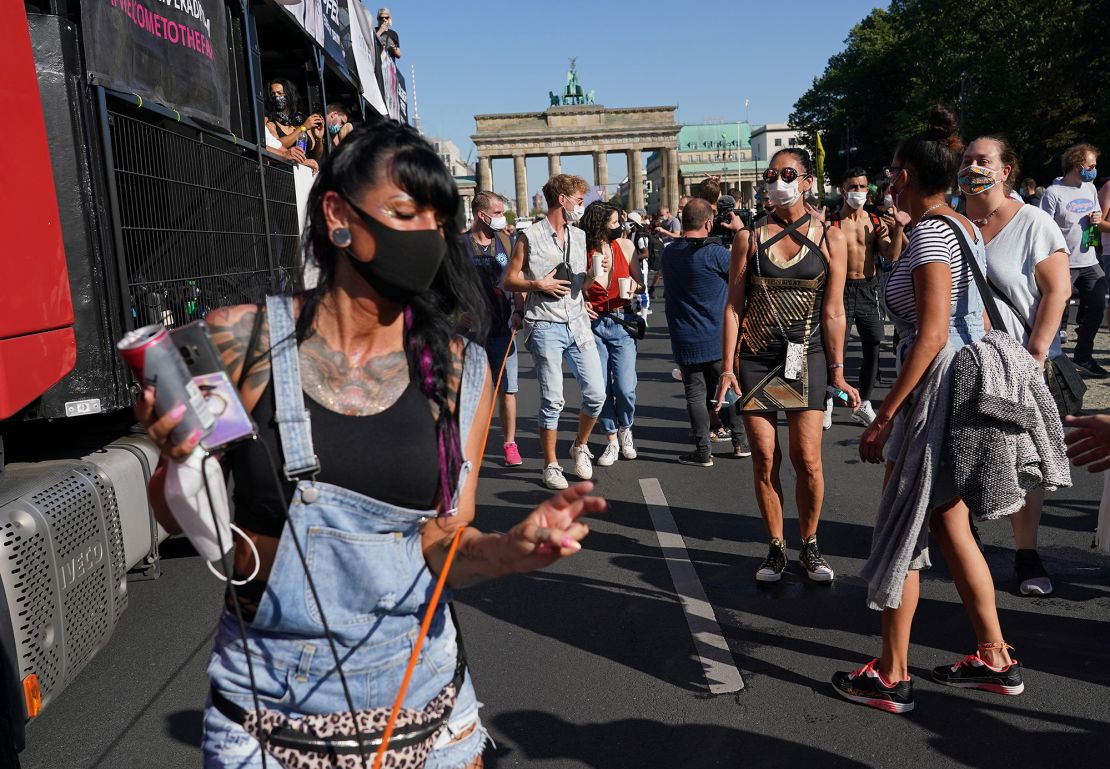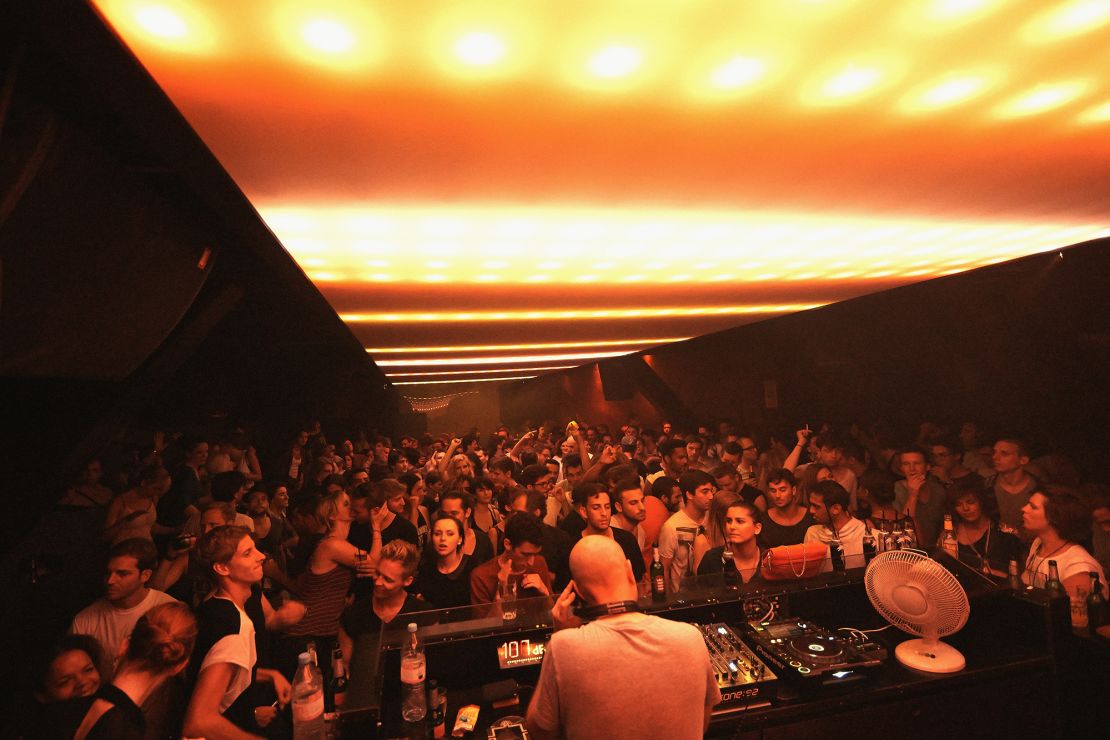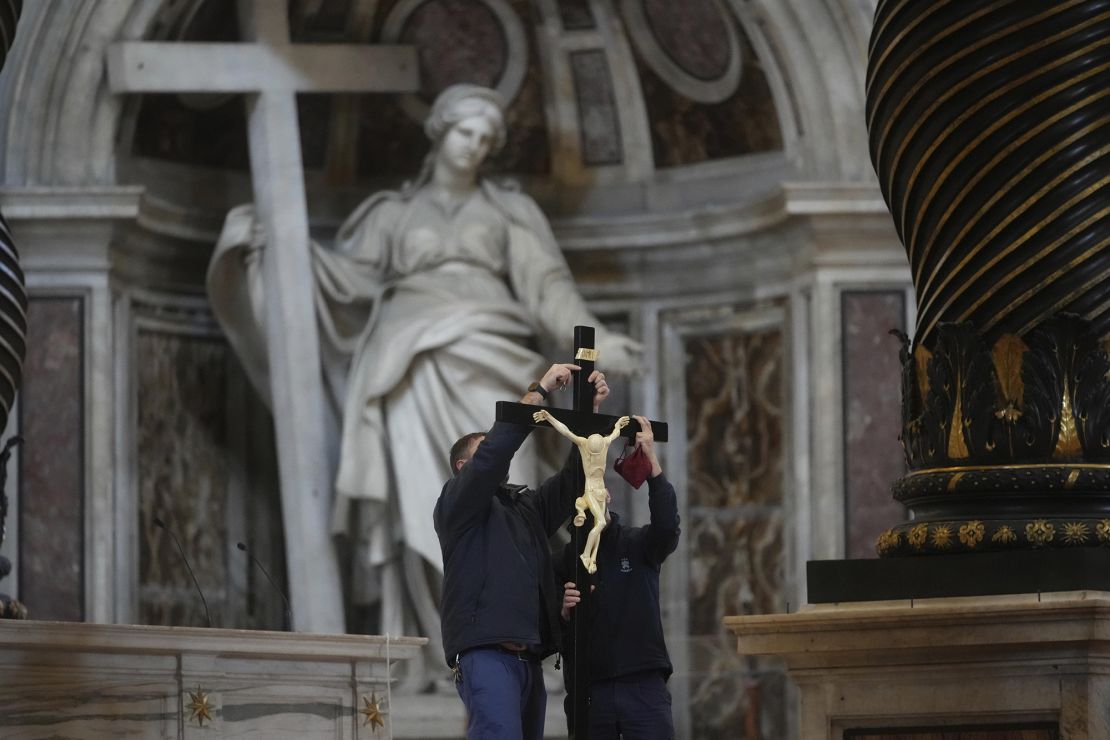Berlin
CNN
—
It’s 2 a.m. and hundreds of people are lined up outside Berlin’s legendary techno club Berghain. Forget the Philharmonic or the Neue Nationalgalerie — this is Berlin’s most famous cultural institution, and throngs of black-clad dance freaks are hoping to make it past the club’s notoriously selective bouncers.
But all’s not well in Berlin’s club scene. Wilde Renate, a funhouse of stacked dancefloors inside a shabby old apartment building just over a mile from Berghain, plans to shutter by the end of the year. Just across the river, the waterside dancefloors at Watergate have sat silent since a final farewell party over New Year’s, ending the club’s 22-year run as one of Europe’s most storied electronic music destinations.
Berlin’s hedonistic, techno-tortured nightlife is deeply interwoven in the city’s cultural identity, and the string of venue closures prompted plenty of hand-wringing about the future amid rising rents, gentrification and shifting party dynamics. Naturally, there’s a German word for the phenomenon: Clubsterben, or club death.
“The days when Berlin was flooded with club-loving visitors are over,” Watergate’s management wrote in an Instagram post last year announcing the decision to close, adding that a “change in the nightlife dynamics of the next club generation and a shift in the relevance of club culture in general” helped prompt the decision to shutter.
An entire younger generation that came of age during the coronavirus lockdowns, when most of Berlin’s clubs were shuttered, was never initiated into Berlin’s famed club culture, one of the club’s owners, Uli Wombacher, told the local Berliner Zeitung newspaper not long after the announcement. “The generational leaps in this business are quick. Two and a half years of closed clubs makes a difference.”
Things have undoubtedly gotten tougher, as the wild and freewheeling Berlin underground that emerged after the fall of the Berlin Wall in the 1990s — when the collapse of communism and a prolonged economic slump meant sprawling abandoned industrial spaces and riverside warehouses made perfect spots for DIY raves — has given way to gentrification and an influx of big business.
Rents are up sharply, costs for energy, staffing and DJs have risen and the jetloads of young tourists who once packed Berlin’s clubs every weekend have fallen off, but if you know where to look, there are still few places on Earth that boast the kind of nightlife that continues to pulse through the German capital. Now, it’s a much more diverse cast of party organizers looking to remake (or perhaps just sustain) a club scene that first vaulted to global fame three decades ago — and to do it, they have to appeal to the younger generations.
But mainstream club culture in Berlin has also hit middle-aged respectability: The parents of Gen Z scenesters once danced at clubs like Berghain and Tresor in their own youth, and staid German politicians applauded last year as the country’s UNESCO commission added Berlin’s techno culture to its list of intangible cultural heritage — a designation also bestowed on things like Turkish bagpiping, European falconry or Inuit drum dancing.
So maybe it shouldn’t be much of a surprise that some of the kids want to shape a party scene of their own. Berlin clubs remain a welcoming destination for partiers and electronic music aficionados even well into middle age and beyond — but while younger clubbers still make up a good chunk of the crowd, their generation isn’t turning out in quite the same numbers.
Part of that might reflect higher costs and healthier lifestyles. For instance, several recent studies have shown Gen Zers around the world are drinking less alcohol.
But younger revelers are also seeking out a looser, more relaxed and freewheeling scene driven by upbeat, bouncier playlists packed with trance and throwback pop. Over the past decade, Berlin has also become far more diverse, and an entire wave of newer collectives are throwing parties built around a broader array of music — from Afrobeat to Arab electronic — in addition to stalwart Berlin club staples like house, techno and hip hop.
“Berlin’s clubbing scene started as counterculture, but now it’s so mainstream and less exciting,” said Jose, a 26-year-old student who grew up in Berlin, who did not want to reveal his full name for privacy reasons. “It’s also very expensive. Maybe that opened the space for other things to emerge. People are going to cultural events, to illegal raves, to more underground or lower-key events.”
Some of Berlin’s most famous old-line clubs have long cultivated exclusive reputations, with hours-long waits outside and tough door policies that have prompted scores of online guides for how to worm your way inside (some suggest donning Berlin’s unofficial all-black club uniform).
Perhaps none are as steeped in legend as Berghain, a towering techno temple in a former East Berlin power plant frequently mentioned as the best club in the world. There, the discerning (or capricious) judgment of the door staff has made the club’s heavily tattooed chief bouncer, Sven Marquardt, a minor celebrity in his own right.
The reverence for places like Berghain reflects just how seriously Berliners take their techno parties — but also grates on at least some partygoers who’ve been seeking out a more carefree atmosphere to just cut loose and relax, instead of stressing about making the cut.
“We’re not looking for this super strict and serious type of going out, which is kind of what I feel like Berlin was to me a while ago,” said Daria, 24, who did not want to reveal her full name for privacy reasons. “When people go out to dance to techno, you’d have to be this specific type of person who takes everything very seriously, who has to stay up super late. It’s something that we’re not looking for anymore.
“For me, clubbing is about spending time with people you like, being able to express yourself freely, being very careless,” she added. “And from what I’ve heard and seen, you can’t really be careless if you don’t know if you’re gonna get in, if you have to behave or look a certain way.”
When people go out to dance to techno, you’d have to be this specific type of person who takes everything very seriously, who has to stay up super late. It’s something that we’re not looking for anymore.
Daria, 24.
The pandemic saw a surge of illegal open-air raves in parks and other open spaces around Berlin, usually in defiance of pandemic rules, and that scene helped fuel a resurgence in the underground party scene. The kinds of empty spaces that fueled the club scene’s rise in the 1990s are mostly long gone from central Berlin, but there are now plenty of raves — some legally permitted, many not — hosted in fields along highways and in abandoned industrial spaces on the far outskirts of the city.
All that’s really needed for a good party, at its core, is a bit of electricity, a halfway decent sound system, a keen crowd — and perhaps a few crates of cheap pilsner.
Some of the more established clubs have also been changing sharply. Suicide Circus, for example, has been around in Berlin in one form or another for more than three decades and has been in a location in a former factory complex near the railway tracks in the heart of former East Berlin since 2009. But in early 2024, the club rechristened itself Lokschuppen (meaning “locomotive shed”) and turned over some of the parties to new event collectives, who brought with them a younger crowd.
“I remember times when people went there just for the club,” one of the club’s managers, Jermaine Fuchs, told the Tagesspiegel newspaper. “Today, guests tend to travel after DJs or collectives.”
Emiko Gejic, spokesperson for the Berlin Club Commission, a group that advocates for Berlin’s club scene, said a whole wave of younger music and events collectives have been bringing “a different style” to Berlin’s club scene and broadening the kinds of offerings in clubs.
“They often host more of a community space. There’s a lot of young collectives — POC collectives, queer-based collectives, FLINTA (female, lesbian, intersex, non-binary, transgender and agender) collectives — that are much more about identity and creating safer spaces,” she said.
“They often host events that have a much more diverse programming with film screenings, with panel talks, with concerts, with live performances. It becomes definitely much more artsy in some way, rather than, let’s say, just a rave where people just go to dance in a dark room with loud techno music.”
Aziz Sarr, 44, grew up around the nightlife scene in Berlin. His father, a DJ originally from Senegal, regularly performed at Dschungel, a renowned hotspot in 1980s West Berlin. He started organizing and DJing his own parties more than a decade ago with a pair of collectives, Freak d’Afrique and RISE, both focused on some of the hottest music coming out of Africa. Along with Ukai Ndame, he opened MAAYA last year in a space next door to Lokschuppen.
When people go out to dance to techno, you’d have to be this specific type of person who takes everything very seriously, who has to stay up super late. It’s something that we’re not looking for anymore.
Aziz Sarr, DJ
“Berlin has become much more diverse, you can see that,” he said. “And all these communities, they want to party, and so of course they shape the nightlife.
“Berlin is definitely one of those cities where you can go out to any kind of music,” said Sarr. “You can go out to an Afropop party, a techno party, a Brazilian party, an Arab electro party, an Arab queer party. I think there’s a party for any scene in Berlin — I think that’s really beautiful and it’s getting more and more diverse.”
Zuher Jazmati started throwing what he calls Arabic queer events with the collective ADIRA in February 2023. He learned to love Berlin’s raucous nightlife scene growing up in the city in the 2000s, and while he complains that a more commercial, mainstream type of clubbing has crowded out some of the counterculture, there’s also been growing space for events beyond thumping raves. ADIRA throws pop parties that pack clubs, but also community events, art shows and book launches.
“A party like ours would not have happened in any of the clubs that you had in Berlin,” he said. “I mean, an Arabic queer pop music party? Where?”
Rising costs have undeniably made it harder for the party scene to thrive, and a higher cost of living in Berlin — which once stood out among major European cities for its relatively cheap rents, which attracted artists and leisure-seeking party types — has put the damper on the party scene. Entry fees that used to hover around 10 to 15 euros ($11 to $17) not long ago have shot upward to 20 or even 30 euros. “A ton of my friends would be down to go out, but they’re just not really able to spend 40 euros,” said Daria.
“It’s becoming a luxurious thing to go out to buy drinks, to consume drugs. That all costs a lot of money,” added Jazmati, 35.
“Maybe some nepo babies, or some upper-class kids, but it’s not something that’s so easy to do as a working-class kid.”
He’s also noticed that the younger crowd doesn’t go out as much, partly after missing out on the ability to let loose at parties during the pandemic in their formative years. But the expense of nights out at established clubs has also driven a younger revival of some underground parties, and Jazmati said he’s hopeful that Berlin will find places — perhaps on the outskirts, in unfashionable neighborhoods or different kinds of spaces — to keep the subculture alive.
“Berlin’s nightlife scene was a subculture that was accessible, that was always for the weirdos, for the ones who never fit into society, who really wanted to have room to escape a little bit,” he said. “This is what makes Berlin fascinating and interesting.”
“For a long time in Berlin culture, clubbing was always extremely accessible for young people, for people’s low income, and that has changed a lot,” Gejic said.
But if there’s also been one constant about Berlin’s nightlife scene over the decades, it’s an older generation telling new arrivals that they’d missed out on all the best parties. “When I got here people already said it’s dead,” DJ, producer and Berlin club veteran Sven von Thülen recently told the city’s English-language magazine, The Berliner, about the club scene in 1996.
“I think the best times are over but I’m not sure where it’s still better, I’ll say it that way,” said Daria. “I mean just quantity-wise, and of the diversity of parties and clubs and people, I think Berlin is still top-notch.”


